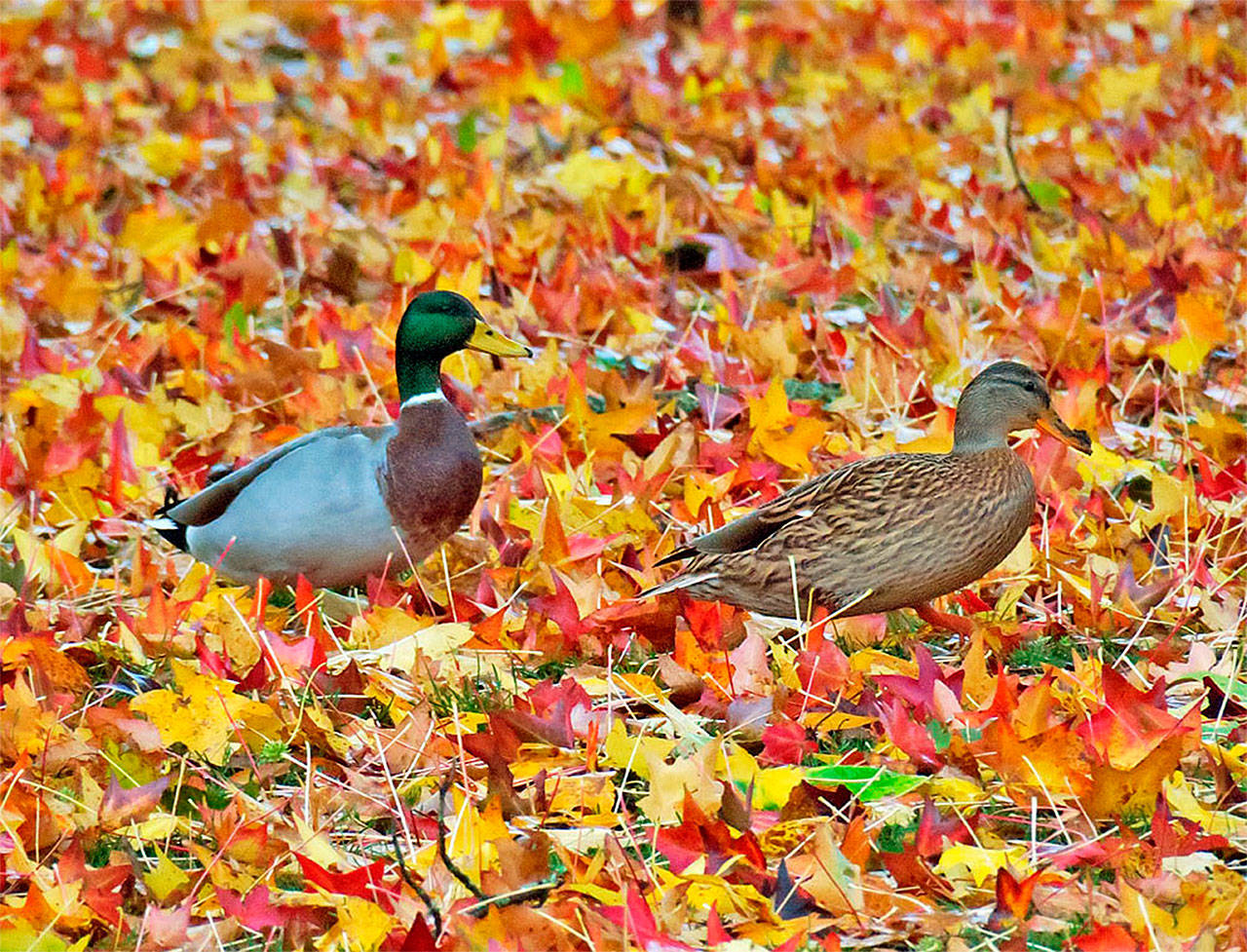By Dianna Moore
Grays Harbor Audubon
Before I begin a bird article I first check my copies to see if I have already written about the bird, so I was surprised to find I have NOT written previously about the Mallard. Perhaps because I knew most everyone knows about Mallards. They are everywhere. But I am sure I can find a few facts that are news to most of the readers. This photo by Mike Hamilton of a mated pair is perfect to illustrate our local population against the gorgeous colors of the fall leaves.
General description: A large, heavy duck, the most familiar duck in the Pacific Northwest, the Mallard is everybody’s favorite at public ponds. Many hang around to eat stale bread thrown by children and their well-meaning parent(s). Males have gray bodies with chestnut-brown breasts, white collars, iridescent-green heads, and yellow bills. Females are mottled brown-and-black with lighter brown heads and necks and yellow bills mottled with black. They have a black stripe running horizontally through the eye. Both sexes have orange feet and a blue speculum, or wing-patch, bordered in white on two sides, best seen in flight. Both sexes are approximately 19 to 26 inches in length, with a wingspan of 32 to 37 inches, and weigh 35 to 46 ounces. During non-breeding, or eclipse, plumage (June to September) both males and juveniles look similar to females. The Mallard is the ancestor of nearly all domestic duck breeds (everything except the Muscovy Duck).
Habitat: Mallards prefer shallow fresh-water marshes but can be seen almost anywhere near water, including drainage ditches along the highway, sewage lagoons, in sheltered bays and estuaries along the coast, and even in swimming pools.
Behavior: Mallards are dabbling ducks and feed by upending in water and using their spatulate bill to pluck aquatic plants and seeds from the bottom of the water feature. They are territorial and will vigorously defend their breeding territory and their mate with chest-bumping and other aggressive behaviors. Males actively chase off other males, often with open bill. Their mating displays are fascinating and varied. Those at public places are accustomed to being around humans and allow close approach, while those out in “the field” are used to being hunted and are much more wary of humans.
Diet: Mallards are omnivores and will eat seeds, stems, and roots from grasses, sedges, and other pond weeds. They also eat aquatic insects and larvae, especially the young birds needing protein. And of course, we humans also feed them; cracked corn is particularly favored by my own pair of visitors. Stale white bread is NOT good for them!
Nesting: The female picks a nest site near water, under overhanging cover on the ground, platform, or even on a stump or in a tree. It’s usually a shallow bowl of plant material lined with down. She incubates seven to 10 eggs for 26 to 30 days. The young leave the nest within a day after hatching and she leads them to water where they feed themselves, but she tends them until they are able to fly at about 52 to 60 days of hatching.
Migration: These ducks remain as far north as weather conditions permit, even overwintering in areas where people feed them. Males leave their mates when incubation begins (as early as mid-March) and gather in large wetlands where they molt into their non-breeding or eclipse plumage and go through a flightless period. They may migrate into warmer areas of open water. Spring migration is usually February and March, with fall migration beginning in late August and lasting through December, with peak movements in October and November.
Conservation status: The Mallard is one of the most abundant ducks in the world. It is a generalist and has adapted to living in close association with humans.
Where and when to find on Grays Harbor: The Mallard is the most widespread and common duck in Washington and can be found on virtually any lowland wetland throughout the state year round, as long as there is open water. The ones in my neighborhood have been enjoying all this rain, paddling around in the flooded camping lots and drainage ditches around town.



